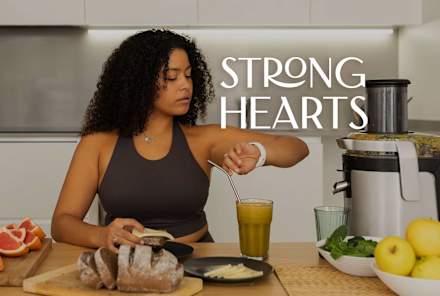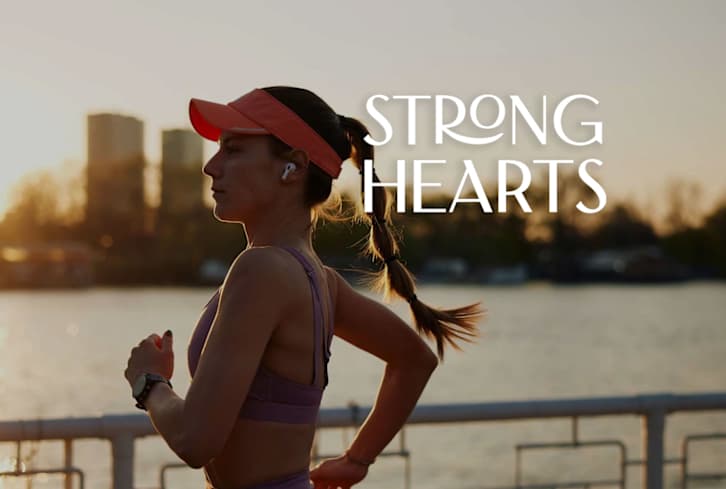Advertisement
Protein Deficiency: Signs, Symptoms & How To Get Back On Track


Protein is critical for providing fuel and energy the body needs, and not getting enough can be detrimental. So, how do you know if you're low in protein and need to up your intake? We consulted health and nutrition experts to nail down the varying degrees of protein deficiency symptoms and explore how to get back on track.
What is protein deficiency?
"Dietary protein provides amino acids for humans to make their own proteins in the body that are essential for growth, development, health, survival, and reproduction," Guoyao Wu, Ph.D., a distinguished professor at Texas A&M University specializing in protein metabolism, tells mindbodygreen.
"A human cannot survive without proteins," internist Diana Lev, M.D., emphasizes. "Every single tissue in the body is built on proteins."
Proteins are made up of some 20 amino acids, and nine of them are only available in food sources. "If your body does not get a continuous, near-daily supply of these essential amino acids, then certain proteins cannot be made, leading to a protein deficiency," says Michael Hirt, M.D., an internal medicine doctor who is also board-certified in nutrition.
Without a sufficient supply of aminos, the body has to start making some pretty tough decisions to stay alive, Hirt adds. "Our emergency systems will break down essential tissues (like your biceps, quads, and skin) and repurpose those quality proteins to repair the heart or blood vessels or make certain life-sustaining hormones and blood proteins."
A protein deficiency commonly happens because of malnutrition, but it could also be hereditary or connected to an underlying health condition, like celiac or Crohn's disease, which can interfere with nutrient absorption.
There are a few types of protein deficiencies, explains J. Wes Ulm, a Harvard- and MIT-trained M.D., Ph.D. with a background in bioinformatics and gene therapy. They are:
- Kwashiorkor: The general term given to a protein deficiency1.
- Marasmus: Marasmus2 entails a broader macronutrient deficiency including proteins. You can also be deficient in specific proteins, such as immunoglobulins (antibodies) or blood plasma proteins like Protein C or Protein S (involved in blood clot regulation), says Ulm.
- Protein-energy malnutrition (PEM): PEM3 is a severe deficiency that could cause "significant immunodeficiency, permanent growth stunting, heart and lung dysfunction, slowing of metabolism, and if not corrected, multiorgan dysfunction and death," says Lev.
There are different severities of protein deficiency, but even a mild one is a cause for concern—particularly in children. Lev explains that "If a young child does not have a sufficient intake of essential amino acids, the building blocks of our proteins, they end up being shorter." She adds that children can also "suffer from increased susceptibility to infections" and look smaller for their age.
Summary
Protein requirements
To avoid a full-blown deficiency, the Recommended Dietary Allowance (RDA) recommendations suggest eating 0.8 gram of protein daily4 per kilogram of body weight.
"In practice, this means about 0.35 grams of protein for every pound that one weighs. So this winds up being roughly 56 grams of protein per day for men, and 45 to 46 grams for women based on the RDA," says Ulm. "Ten to 35% of a daily diet should be composed of protein."
He adds, "These are general guidelines, however, and are on the low end for individuals with protein deficiencies."
Those who are looking to build and maintain muscle mass will also want to eat more protein than the RDA calls for; at least 100 grams a day for most people.
The elderly
Protein experts recommend a higher protein intake for the elderly, ranging from 1.2 to 2.0 grams per kilogram of body weight per day5.
Vegans
While vegans should follow the same recommended protein targets, they should be mindful of the sources of protein they consume.
"People who do not consume any or sufficient animal-sourced proteins need to be vigilant to ensure that they are feeding the body all nine of the essential amino acids," Hirt notes. "This is not hard to do but does require some basic planning to ensure a full spectrum of amino acids is regularly consumed." Here's a primer on how to make sure you're getting enough protein on a vegan diet.
Summary
Symptoms of a protein deficiency
There are many signs of a protein deficiency to watch out for. Not everyone will have the same symptoms, but here are a few to be mindful of:
Muscle wasting
A lack of protein can lead to muscle weakness. "Unlike other macronutrients, protein does not have a storage form (e.g., the way glycogen is used for glucose). As a result, general protein deficiencies will lead the body to 'harvest' needed protein from muscle, leading to loss of muscle mass. This process is known as muscle catabolism6," Hirt explains.
As a result, the body's muscles start to dramatically shrink, leading to an unhealthy, muscle-wasted appearance.
Edema
"Edema is frequently seen in the legs and feet but can also be visible on the face, arms, and abdomen, depending on severity. In kwashiorkor, it's especially prominent around the belly," Ulm explains.
"A tragic but classic picture of severe protein malnutrition is a protein-starved child who looks emaciated but for the large swollen belly full of fluid, not fat," adds Hirt.
Increased vulnerability to infections
Protein deficiencies can weaken the immune system8, hindering the body's ability to fight off infection. Ulm says, "Our immune systems rely heavily on circulating proteins, including a group called the complement cascade and immunoglobulins, i.e., our antibodies, as well as a number of key enzymes and other proteins within cells. Protein deficiencies can therefore rapidly lead to immune deficiencies and enhanced vulnerability to infections caused by a variety of diseases."
Brittle nails and hair
Brittle nails and hair are another physical sign of not eating enough protein. "Since the body's exterior is largely made of protein, the first signs of protein deficiency are often on the surface," Hirt says. For example, you may notice flaky, peeling skin, weak nails, and hair that is brittle, comes out in clumps, and loses its natural color. "Once you have these symptoms, you have moderate protein deficiency. There are other causes for this, so please see your doctor," Lev notes.
Low energy
Feeling constantly tired and sluggish is a common symptom of a protein deficiency, which can greatly affect kids in particular. "Children who suffer from low energy in school cannot participate adequately in sports, suffer from recurrent infections, have more absences, and fall back in class," Lev says.
Who is at risk for a protein deficiency?
It's a popular misconception that protein deficiencies are a rare occurrence in the United States, but the health problem happens more often than people think.
"Protein deficiency is a common nutritional problem in developing nations but also occurs in some populations in developed countries," Wu says. Some of the top risk factors for protein deficiency in developed countries like the U.S. include:
- The elderly: More than 50% of home-bound elderly individuals9 in the U.S. are deficient in protein, notes Wu.
- Those living in poverty: Lev points out that food insecurity is also one of the main contributing factors for protein deficiencies in the U.S., saying, "Many people do not have the money to afford adequate essential proteins for their family. People immigrating here from other countries lacking in adequate essential protein tend to still suffer from malnutrition... Their children who are raised in the U.S. get the benefit of school lunches and grow up inches taller than their parents."
- People who are very active: Others at risk include people who exercise frequently. "Adults who perform intense exercise are also at risk for protein deficiency if they do not consume sufficient protein, particularly animal protein," Wu says.
- Those with injuries and chronic illness: People with a weakened immune system should also pay attention to their protein intake, Wu advises. "Protein deficiency also occurs in individuals with burns, severe infections, and cancers," he adds.
- Pregnant people: Experts advise expecting parents with morning sickness to be extra careful of their protein consumption10, as vomiting many times a day can cause protein malnutrition.
How do you fix a protein deficiency?
If you suspect you have a protein deficiency, visit a doctor, as some of the symptoms can also be signs of other conditions.
A protein deficiency can have serious health consequences, but the good news is that the solution to the problem is simple: Eat protein!
This can come from animal sources (eggs, beef, fowl, seafood, and dairy products) or plant sources (nuts, seeds, vegetables, soy products), and protein powders can be used to fill gaps.
It's also worth noting that making systemic changes to eradicate food insecurity will reduce protein deficiency on a wider scale. Taking measures like investing in healthy school lunches, bringing healthy food to food deserts, and making nutrition information more accessible will all help.
Summary
High-protein foods:
Looking to start upping your intake? Here are a few foods that are higher in protein.
- Peanut butter: 24 g of protein per serving11
- Chicken: 23.9 g of protein per serving12
- Beef: 23.4 g of protein per serving13
- Cheddar cheese: 23.3 g of protein per serving14
- Tuna: 19 g of protein per serving15
- Fish (Haddock): 16.3 g of protein per serving16
- Eggs: 6 g of protein per egg 17
- Tofu: 9.41 g of protein per serving18
- Lentils: 9.2 g of protein per serving19
Low-protein foods:
While these bring other nutrients to the table, they are examples of foods that won't add much protein to your meals:
- Coconut oil: 0 grams of protein per serving 20
- Roma tomato: 7 g of protein per serving 21
- Grapes: 0.9 g of protein per serving22
- Apple: 0.13 g of protein per serving23
- Iceberg lettuce: 0.74 g of protein per serving24
- Red onion: 0.94 g of protein per serving 25
- Cherries: 1.04 g of protein per serving 26
- Marinara pasta sauce: 1.41 g of protein per serving27
FAQ
Can you eat too much protein?
Protein is vital for maintaining overall health, but consuming too much can be dangerous for those with existing kidney issues. "Consuming too much protein over extended periods of time can also create poor health," Hirt says. "Excess protein must be cleared by the kidney and the intestines. Stressing the kidneys can cause damage to their delicate filtration mechanisms, and too much dietary protein can cause significant constipation for the gut."
How long does it take to recover from protein deficiency?
While severe, famine-like protein deficiencies require medical supervision, they can be treated relatively quickly. "Like adding water to a dried-up, nearly dead plant, replenishing quality dietary protein typically demonstrates very quick turnarounds in a matter of days," Hirt says. More mild protein deficiencies are easier (and just as quick) to correct. "The body wants to store [protein] as an energy reserve, so as you eat protein-rich foods, it immediately restores it," Lev adds.
What are the signs of protein deficiency?
Signs of a protein deficiency include muscle wasting, edema (swelling), low energy, vulnerability to infection, and brittle hair and nails.
The takeaway
Protein deficiency can be a serious condition in which the body struggles to carry out essential functions. Signs of a deficiency include muscle wasting, swelling, low energy, vulnerability to infection, and brittle hair and nails. Even those who don't have a severe deficiency may notice a positive difference when they eat more protein. Here's a complete guide to getting enough of it daily.
27 Sources
- https://www.ncbi.nlm.nih.gov/books/NBK507876/
- https://pubmed.ncbi.nlm.nih.gov/32644650/
- https://www.sciencedirect.com/topics/medicine-and-dentistry/protein-calorie-malnutrition
- https://pubmed.ncbi.nlm.nih.gov/26797090/
- https://www.ncbi.nlm.nih.gov/pmc/articles/PMC4924200/
- https://www.ncbi.nlm.nih.gov/pmc/articles/PMC3775123/
- https://www.ncbi.nlm.nih.gov/books/NBK537065/
- https://pubmed.ncbi.nlm.nih.gov/17403271/
- https://link.springer.com/article/10.1007/s12603-019-1174-1
- https://www.ncbi.nlm.nih.gov/pmc/articles/PMC5882021/
- https://fdc.nal.usda.gov/fdc-app.html#/food-details/2262072/nutrients
- https://fdc.nal.usda.gov/fdc-app.html#/food-details/331897/nutrients
- https://fdc.nal.usda.gov/fdc-app.html#/food-details/746760/nutrients
- https://fdc.nal.usda.gov/fdc-app.html#/food-details/328637/nutrients
- https://fdc.nal.usda.gov/fdc-app.html#/food-details/334194/nutrients
- https://fdc.nal.usda.gov/fdc-app.html#/food-details/333374/nutrients
- https://fdc.nal.usda.gov/fdc-app.html#/food-details/747997/nutrients
- https://fdc.nal.usda.gov/fdc-app.html#/food-details/411177/nutrients
- https://fdc.nal.usda.gov/fdc-app.html#/food-details/175254/nutrients
- https://fdc.nal.usda.gov/fdc-app.html#/food-details/330458/nutrients
- https://fdc.nal.usda.gov/fdc-app.html#/food-details/1999634/nutrients
- https://fdc.nal.usda.gov/fdc-app.html#/food-details/2346413/nutrients
- https://fdc.nal.usda.gov/fdc-app.html#/food-details/1750341/nutrients
- https://fdc.nal.usda.gov/fdc-app.html#/food-details/2346388/nutrients
- https://fdc.nal.usda.gov/fdc-app.html#/food-details/790577/nutrients
- https://fdc.nal.usda.gov/fdc-app.html#/food-details/2346399/nutrients
- https://fdc.nal.usda.gov/fdc-app.html#/food-details/332282/nutrients


















